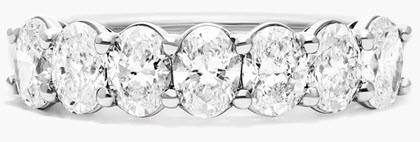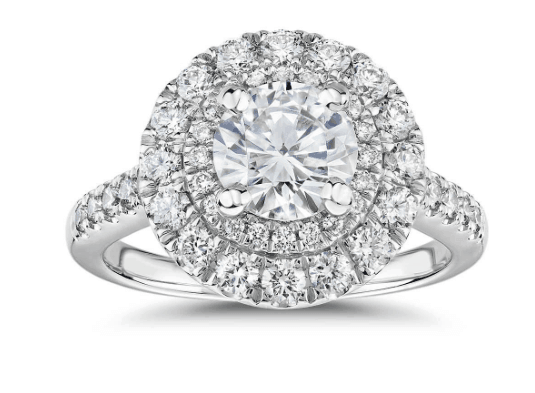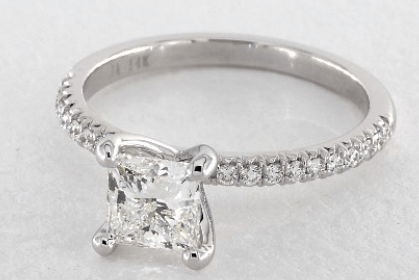What is CTTW and CTW in Diamonds?
What carat total weight (CTTW) means and is it important?
We are reader-supported. Buying through any red colored link on our site may earn us commissions. Learn More.
What carat total weight (CTTW) means and is it important?
When discussing diamonds, CTW and CTTW are acronyms you’ll often encounter, referring to “Carat Total Weight” and “Carat Total Weight,” respectively. Essentially, both terms indicate the total carat weight of all diamonds in a piece of jewelry, such as a ring with a central diamond and additional side or accent diamonds. However, CTW and CTTW should not be confused with the term “carat,” which often refers to the weight of a single, central diamond in a piece of jewelry.
The key difference between CTW/CTTW and carat lies in what each measures. While “carat” generally applies to the main diamond alone, CTW or CTTW encompasses the weight of all diamonds involved. For instance, a ring described as having a 1-carat center stone with 0.5 CTW means the center stone weighs 1 carat, and the total weight, including side or accent diamonds, is 1.5 carats.

What does CCTW mean?
CCTW vs. Carat
Total carat weigh and diamond prices
What to look for in diamonds
Why you should trust us
CTTW stands for “carat total weight,” or “total carat weight.” It’s a metric that’s used to measure the total weight of all of the diamonds in a specific piece of jewelry, such as a tennis bracelet or a pavé diamond ring.
You might see “CTTW” written as “CT TW” for some engagement rings. CT stands for “carat,” a unit used to measure a diamond’s weight. TW is short for “total weight” and is used to measure the total weight of all diamonds in a piece of jewelry.
The carat weight of one diamond and the total carat weight of a diamond ring are very different numbers — a fact that can cause some confusion for first-time buyers. Below, we’ve explained how CTTW works, as well as how it differs from other measurements of a diamond’s weight.
As we covered in our guide to diamond carat weight, the carat weight of a diamond refers to the amount the diamond weighs, not its size. A diamond of a single metric carat weighs exactly 200 milligrams and can range in diameter from 5.60mm to 6.60mm depending on its cut grade.
Carat weight is abbreviated at “ct.” When you’re viewing loose diamonds online, you’ll generally see their carat weight listed alongside factors such as cut, color and clarity.

As the American Gem Society explains, one carat “equals 0.200 grams or 1/5 gram and is subdivided into 100 points. For comparison, in units more familiar in the United States, one carat equals 0.007 ounces.”
CTTW, on the other hand, refers to the total weight of all of the diamonds in a specific piece of jewelry. Unlike ct., which is used to show the weight of a loose diamond or center stone, CTTW is only used to display the total carat weight of all diamonds.
If you’ve read any of our other guides, you might have also seen the acronym “CTW” used to refer to total carat weight. Both CTTW and CTW are used worldwide and have the exact same meaning.
Many engagement rings only contain one center diamond. For example, this knife edge solitaire setting from James Allen is designed to only hold a center stone. As a result, the ring’s total carat weight (CTTW) will be the same as the carat weight of the center stone.
Other rings, such as this lotus basket pavé engagement ring from James Allen, have a band that’s lined with small diamonds. This specific ring features 36 small round diamonds, adding up to a total carat weight of 0.25 carat without a center stone.
The total carat weight, or CTTW, of this ring is calculated by adding together the carat weight of the pavé set diamonds and the weight of the center stone. For example, by selecting this 1 carat round H VS2 diamond from James Allen, the total weight of the setting and center stone is 1.25 carats.
Some engagement ring settings can have a significant total carat weight even before the center stone is added. For example, this grande halo split shank setting from James Allen has a 0.70 CTTW without any center stone due to its 64 pavé and halo set diamonds.
The price of a diamond increases exponentially with its carat weight. For example, a 0.52 carat round, H color, VS2 diamond like this one from Blue Nile sells for $960. A 1.03 carat diamond with the same specifications costs $4,650, despite only being twice the carat weight.
The reason for this is simple. Large diamonds are significantly rarer than smaller diamonds and as a result, they can command higher prices on the market. Because of this, a large diamond is always going to be worth significantly more than a smaller diamond of the same quality.

This isn’t the case with a ring’s total carat weight. Because this figure is made by adding up the carat weight of all of the ring’s small diamonds, there isn’t an exponential relationship between the ring’s total carat weight and its value.
For example, mounted in this solitaire setting from Blue Nile, the 1.00 carat H color, VS2 diamond above costs $5,050 in total. This ring has a total carat weight of 1.00 carat.
Meanwhile, this 0.5 CTTW pavé engagement ring from Blue Nile with this 0.50 carat H color, VS1 diamond is available for $1,410. It also has a total carat weight of 1.00 carat.
This means that if you’re on a limited budget, a pavé or halo setting with a fairly high total carat weight but a small center stone could be a good idea. While you won’t get the full wow factor of a large center stone, a ring of this type can look beautiful and elegant, all at a lower cost.
The carat weight of a diamond — or, in this case, the total carat weight of a ring — is only one of several factors you should consider when you’re choosing an engagement ring.
Other factors, such as a diamond’s cut, color and clarity, also play a role in its appearance and value. Known as the 4 Cs of diamonds, these factors all interact with each other to affect the way a diamond looks and the amount you’ll pay for it.
As the GIA explains, “jewelry professionals use a systematic way to evaluate and discuss these factors” and assess a diamond’s quality and value. This means using objective measurement systems for factors such as diamond cut quality, color and clarity, not just its carat weight (or the total carat weight of several diamonds).
We’ve covered these in more detail, as well as what you should look for, in our guide to buying a diamond.
CTTW, or total carat weight, always refers to the total weight of all diamonds in a ring, bracelet, earrings or other pieces of jewelry. When you’re viewing a setting on its own, it’s the weight of the halo or pavé diamonds. For a complete ring, it’s the weight of all small diamonds and the center stone.
Carat weight, which is abbreviated as ct, cw or CW, only refers to the weight of the center stone on its own.
While a ring with a large total carat weight can look impressive, it’s important to remember that the weight of the center stone is usually the biggest factor in determining an engagement ring’s value.
Need help buying diamond jewelry? Contact our experts and we’ll help you choose the highest quality loose diamond, engagement ring, bracelet, pendant or earrings for your budget.




Before you buy a diamond, get personal buying advice from industry veterans. We'll help you get the best diamond for the money.
DISCLAIMER: We don't use your email for marketing. Period.
A diamonds’ price is determined primarily by the 4 Cs of the diamond. On the wholesale level, diamond prices are first based on a diamond shape and
Buying an engagement ring is often one of the first major purchases in a person's life. The process can be fraught with tension as there are so m
A wide range of 1 carat diamonds exist both in online markets and local diamond jewelry stores. Not only are there significant differences in beauty
Please enter your email address to receive your 25% off coupon code:
Here is your coupon code: GFDSF3GF